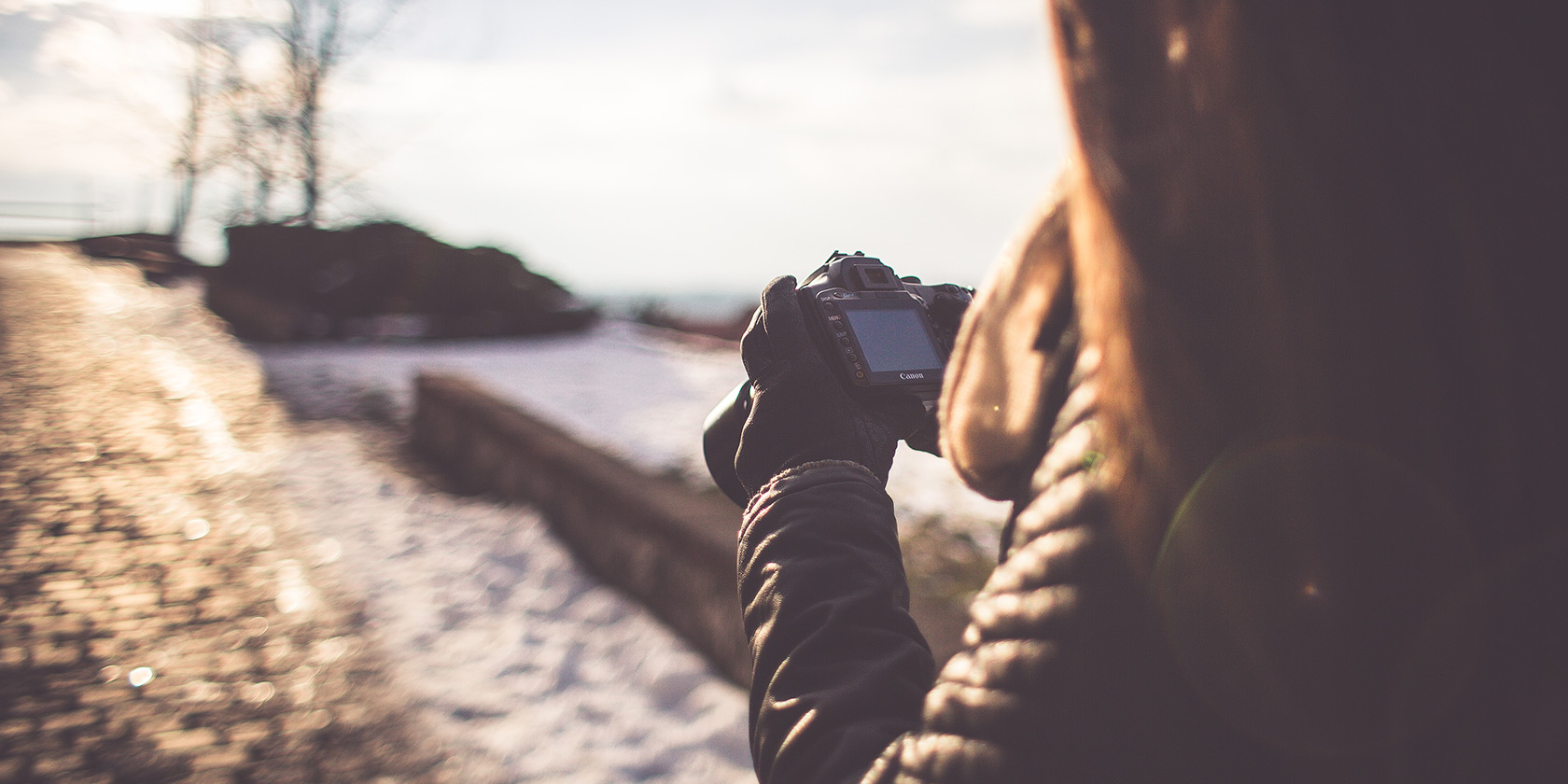
Despite how easy it looks, photography is hard, with three learning curves to conquer: the technical aspects of the camera, the theory of light and shadows, and the actual composition of a photo (sometimes called “seeing the shot”).
That last part is the hardest thing for beginners to grasp. Composition has an artsy component that can’t be easily taught. It must be discovered by the photographer themselves.
Fortunately, there are photography exercises that can help “develop your photographic eye”. And with practical experience being the only guaranteed way to understand composition, these are the most effective photography exercises we’ve found.
1. Crop Someone Else’s Photos
Great photography starts with the eye, not the camera. This means it should be possible to develop your photographic eye without ever touching a camera or lens. And it is! For this photography composition exercise, all you’ll need is one of the easy-to-use photo editing programs like Paint or GIMP.
First, learn the fundamental rules of photo composition. You don’t have to know every single one of them right now, but you should know at least one, as this exercise will force you to put these rules into practice. We recommend starting with the Rule of Thirds.
Next, go to a free photo-hosting site like Flickr or 500px and download a bunch of images to your computer. (The easiest way is to right-click and “Save Image As”). Any kinds of images will work, but this exercise works best with portraits and landscapes.

Now, open one of the images in your photo editing program of choice and start cropping. Try all of the standard aspect ratios, including 1:1, 4:3, 3:2, and 16:9. Try cropping vertical photos as horizontal, or horizontal photos as vertical. Move the subject around. Be creative.
The point is to experiment and see how different crops can change the look and feel of an image, and how certain crops are more aesthetically pleasing than others. This experience is invaluable when you start framing your own shots through the viewfinder.
NB: You can play around with someone else’s images, but do NOT upload them or republish them on the internet in any way. That would be a violation of copyright law unless you have express permission from the image’s original owner.
2. With One Subject, Shoot 10 Photos
Here’s a common mistake made by newbies: always taking photos from the same height and from the same angle. It’s natural to stand up straight and take snapshots from eye-level, but that’s boring. After all, everyone knows what the world looks like from eye-level.
If you want your photos to be more compelling, change things up. Capture the world from unusual angles and positions: viewpoints that are foreign to most people.

This photography exercise helps train your sense of angles. First, find a subject. Any subject. It could be a stove-top kettle, a pet dog, a fire hydrant, a herb garden, a manhole cover. Anything works.
Then take 10 photos of it. No two photos should be alike. Try looking directly down at it. Then try looking directly up at it. Shift the angles. Look at the front of the subject, then the back, then the sides.
The possibilities are countless, and even the smallest tweaks to the angle can have a large impact on the resulting photo. Do this for hundreds of subjects and you’ll start seeing angles everywhere you go without even trying.
3. With Three Objects, Shoot 10 Photos
In some cases—like landscape, astronomical, and street photography—the idea is to capture scenes in the moment as they are. In other cases—like portrait, food, and product photography—the idea is to construct your own scenes.
As you imagine, this isn’t easy. There are many factors to juggle such as lighting and background, but one particular aspect that newbies find difficult is how to position multiple subjects within the frame.

That’s what this photo composition exercise is about. Find three random objects, such as action figures, fruit, bowls, candles, plants, or whatever else you have to hand. It doesn’t matter if they’re related to each other or not, although it will be easier if they’re all similar in size.
Now position them however you wish. Think of it as if you’re composing the objects for a photo shoot (that is what you’re doing, after all). Do this 10 times, rearranging them in different ways each time. Over time, this will stretch your creative muscles and develop your eye.
4. With One Lens, Shoot 1,000 Photos
The focal length of a lens controls more than just the zoom factor of a shot. Yes, all things being equal, an 18mm lens requires you to be closer to the subject than a 50mm lens or an 85mm lens. But different focal lengths can evoke different feelings from a photo, too.
For example, the wide angle of an 18mm lens comes with a lot of distortion, which can produce a comical or whimsical effect. On the other hand, a 200mm lens has a compression effect that makes the photo seem flatter than, say, an 85mm or 50mm lens.

In short, different focal lengths require different approaches when composing shots. That’s why we recommend mastering one kind of lens at a time, preferably starting with a 50mm prime. Read up on the common camera lenses and when to use them.
For this exercise, all you have to do is stick with one focal length for your next 1,000 photos. It’s easiest with a prime lens, but if you only have a zoom lens, just pick a focal length and leave it there. Switch to another focal length when your 1,000 photos are complete.
By the end, you will have a better understanding of how to use the different focal lengths at your disposal to achieve the shot you’re after.
5. Hula-Hoop Photo Walks
Creativity is often seen as something that’s infinite, and full of possibilities. And while there’s technically nothing wrong with that, the truth is that creativity needs limits and constraints to really flourish.
If you’ve ever felt like you wanted to take photos but didn’t know where to start, where to go, or what to shoot, then you’ll know what I’m talking about. Restrictions are good, and that’s how this photo exercise is going to unlock your creative potential.

Take a hula hoop and go outside. Toss it up into the air, then let it bounce and roll around until it eventually comes to a stop. Now stand inside the hula hoop, take a look around, and shoot 10, 20, or 50 photos of anything. But try to make them good.
When you’re done, toss the hula hoop into the air again and repeat the process. If you don’t have a hula hoop, just pick a random direction and walk a random number of steps to find your next spot. Pretty soon your creative juices will start flowing, guaranteed.
6. Weekly Photo Challenges
Weekly photo challenges are popular on the internet, but different photography communities have different names for them: Photo of the Week, 52 Photos Project, Sunday Photo Prompt, etc. The key is to take 52 photos over the course of one year.

Ideally, you’d take part in some kind of community version of the challenge because this gives you a chance to see the photos of other participants, and a chance for others to critique your work. But if you’d rather do a personal challenge instead, that’s fine too.
Sometimes each month has a theme, but not always. It’s up to you how you want to do it. We recommend setting a regular weekly deadline and sticking to it. Need inspiration? Check out 52 Weeks Photography Challenge, 52 Frames, or 52 Weeks of Photography.
7. Recreate Someone Else’s Photos
Once you feel a little more comfortable behind the camera, you may want to try recreating photos that others have shot. Browse Instagram, Flickr, or 500px, pick a few that seem within your skill range, and have at it!

The goal here isn’t to make an exact 1-to-1 replica of your source material, so don’t be discouraged if you can’t get that far. Rather, this photography exercise is meant to get you thinking in ways you haven’t considered. To push you outside your comfort zone.
At first, your imitation photos will look like garbage compared to your source photos. That’s normal. Keep at it, however, and you’ll start to see fast improvements. Along the way, you may even start to discover your own voice and sense of style as a photographer.
Photography Is a Long But Rewarding Journey
Don’t expect to unlock your photographer’s eye overnight. It’s a gradual process that could take weeks, months, or even years before you really start to “see” photographs before taking them. But the journey is well worth taking, so don’t give up!
If these photography exercises weren’t enough and you need even more ideas, then we highly recommend checking out these free lessons to learn the basics of photography.
Read the full article: 7 Skill-Building Photography Exercises That Really Work


